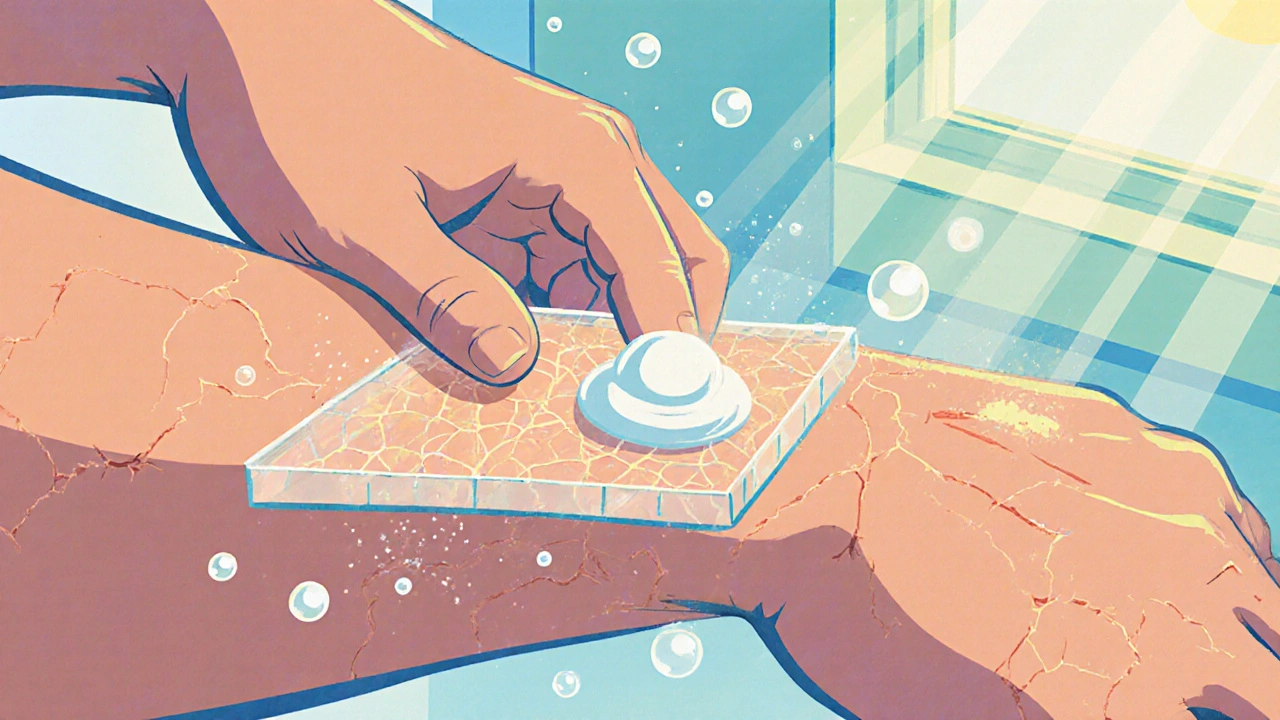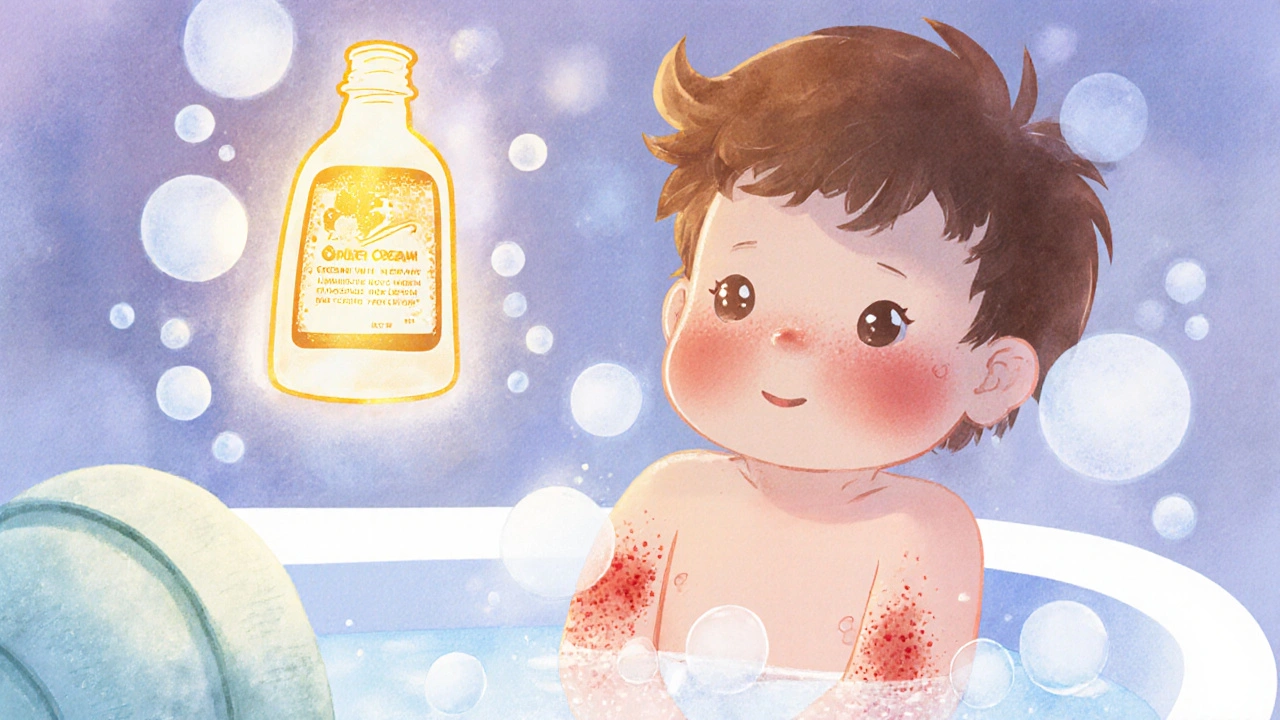Atopic dermatitis isn’t just dry skin. It’s a stubborn, itchy, red rash that comes back again and again - often without warning. For many, it starts in childhood and sticks around for years, sometimes decades. The itch doesn’t just annoy; it disrupts sleep, ruins confidence, and turns everyday activities into battles. And no matter how many creams you try, if you don’t understand what’s making it worse and how to fix your skin’s broken barrier, you’re just spinning your wheels.
What’s Really Going On With Your Skin?
Atopic dermatitis, often called eczema, isn’t caused by allergies alone or poor hygiene. It’s a genetic condition where your skin’s natural defense system breaks down. People with this condition often have a mutation in the filaggrin gene, which is responsible for keeping moisture in and irritants out. When that gene doesn’t work right, your skin loses water 2 to 3 times faster than normal skin. That’s why it feels tight, cracked, and flaky even after moisturizing. This barrier defect also lets bacteria, allergens, and chemicals slip through. Your immune system reacts, causing inflammation - the redness, swelling, and intense itch. And here’s the trap: scratching makes it worse. It tears the skin further, lets in more irritants, and triggers more inflammation. It becomes a loop - itch, scratch, flare, itch again.What Triggers Your Flares? (It’s Not Just Stress)
Stress gets all the attention, but the real culprits are often invisible and everyday. Here’s what actually sets off flares based on real patient data and clinical studies:- Cold, dry air: When humidity drops below 40%, flares increase by 37%. Winter isn’t just uncomfortable - it’s a trigger.
- Heat and sweat: Over 68% of people report flares when temperatures hit 80°F (27°C) or higher. Sweat irritates the already damaged skin barrier.
- Harsh soaps and cleansers: Sodium lauryl sulfate, found in many body washes and shampoos, disrupts the skin barrier at concentrations as low as 0.5%. That’s in a lot of “gentle” products.
- Fragrances and preservatives: 15% of people flare from added scents. Another 2-5% react to preservatives like methylisothiazolinone or parabens, even in “hypoallergenic” brands.
- Hard water: In areas with high mineral content, soap doesn’t rinse well. Residue stays on skin and acts like an irritant.
- Dust mites and pet dander: These aren’t just allergy triggers - they directly worsen inflammation in sensitive skin.
Emollient Therapy: The Only Treatment Everyone Agrees On
The American Academy of Dermatology, the International Eczema Council, and even Reddit’s 145,000-member eczema community all agree on one thing: emollients are the foundation. Not steroids. Not antihistamines. Not diet changes. Emollients. An emollient isn’t just lotion. It’s a repair kit for your skin. It works in three ways:- Occlusives (like petrolatum) form a protective film that locks in moisture. Petrolatum reduces water loss by up to 98%.
- Humectants (like glycerin) pull water into the skin. The sweet spot is 40-50% concentration - too little does nothing, too much can dry you out.
- Emollients (like ceramides) fill the gaps between skin cells. People with atopic dermatitis are often missing key ceramides - replacing them helps rebuild the barrier.

How to Apply Emollients Right (Most People Get It Wrong)
You can buy the best emollient in the world, but if you apply it wrong, it won’t work. Here’s what actually works:- Bath first: Take a 15-20 minute lukewarm bath. No hot water. No scrubbing. Just soak.
- Pat dry: Gently dab your skin with a towel. Leave it slightly damp - don’t rub it completely dry.
- Apply within 3 minutes: This is non-negotiable. Moisture trapped on your skin gets sealed in. Waiting longer than 3 minutes cuts moisture retention by half.
- Use enough: For adults, aim for 250-500 grams per week. That’s about a full tube of CeraVe or Eucerin every 3-4 days.
- Apply in downward strokes: Never rub up and down. Always stroke in the direction your hair grows. Rubbing irritates the skin.
- Use finger units: One finger unit (the amount squeezed from a tube along the length of an adult finger) covers two adult palms. Use 2-3 finger units per body part (arm, leg, chest).
Which Emollients Actually Work?
Not all moisturizers are created equal. Here’s what dermatologists and patients consistently report as effective:| Product Type | Key Ingredient | Pros | Cons |
|---|---|---|---|
| Petrolatum (Vaseline) | 100% petrolatum | Most effective barrier repair, cheap, fragrance-free | Very greasy, messy |
| CeraVe Moisturizing Cream | Ceramides 1, 3, 6-II + hyaluronic acid | Restores barrier, non-greasy, contains no fragrance | Higher cost (~$19/tube), not always covered by insurance |
| Eucerin Advanced Repair Cream | Ceramides + urea | Good hydration, less greasy than petrolatum | Urea can sting on cracked skin; 42% of users report sticky residue |
| Vanicream Moisturizing Cream | Simple formula: no dyes, fragrance, parabens | Great for sensitive skin, widely available | Less ceramide content, slower barrier repair |

Why Most People Stop Using Emollients (And How to Stay on Track)
Here’s the hard truth: 70% of people stop using emollients within six months. Why?- It feels greasy. Especially petrolatum. People hate the stickiness.
- It takes time. Applying 250-500 grams a week isn’t quick. Busy parents, shift workers, teens - they skip it.
- They don’t see instant results. Unlike steroid creams that calm redness in hours, emollients work over weeks.
- Cost adds up. Prescription-grade emollients can cost $15-$20 per tube. Insurance doesn’t always cover them.
When Emollients Aren’t Enough
Emollients are the base layer - like putting on a t-shirt before a jacket. But if your skin is severely inflamed, cracked, or bleeding, you need more.- Mild flares: Emollients alone can clear them in 30-40% of cases.
- Moderate to severe flares: You’ll need a topical steroid or calcineurin inhibitor (like tacrolimus) on top of your emollient. Apply the steroid first, then seal it in with emollient 15 minutes later.
- Chronic, uncontrolled cases: Biologics like dupilumab reduce flares by 70-80%. But even these only work if you’re still using emollients daily.
The Future: Smarter Emollients and Personalized Care
The field is changing fast. In May 2023, the FDA approved the first emollient with sustained-release ceramides - it keeps working for 12 hours, not just a few. Researchers are now testing emollients that target the skin’s microbiome, specifically reducing Staphylococcus aureus, a bacteria that worsens eczema in 8-12% of patients. Smart dispensers that track how much you use and send reminders are in pilot testing. And in 2024, guidelines increased the recommended weekly dose from 100g to 200g for adults - because we now know more is better. But the biggest breakthrough isn’t new technology. It’s realizing that emollient therapy isn’t optional. It’s not a luxury. It’s the most important thing you do for your skin every single day.Can I use regular body lotion for atopic dermatitis?
No. Most regular body lotions are water-based with fragrances, alcohol, or preservatives that irritate damaged skin. They give a quick feel-good effect but don’t repair the barrier. Look for products labeled “fragrance-free,” “hypoallergenic,” and containing ceramides, petrolatum, or glycerin. Avoid anything with “perfume” or “parfum” on the ingredient list.
How much emollient should I use per application?
Use 2-3 finger units per body part - like one arm or one leg. For an adult, that’s about 1-2 tablespoons per session. Apply twice daily. Over the week, aim for 250-500 grams total. If you’re using less than 100 grams per week, you’re not using enough to make a difference.
Is it better to use ointments or creams?
Ointments (like petrolatum or thick creams) are better for very dry, cracked skin because they seal in moisture better. Creams are lighter and easier to use during the day. Lotions are usually too watery and evaporate quickly. For nighttime, go with ointment. For daytime, a cream works fine. The key is consistency - not the form.
Can emollients cause skin reactions?
Yes, but rarely. About 5.7% of people react to preservatives like methylisothiazolinone, which is still found in some products. If your skin stings, burns, or gets redder after applying, stop using it. Switch to a product labeled “preservative-free” or “for sensitive skin.” Vaseline and Vanicream are among the safest options.
Do I need to use emollients forever?
Yes - but not necessarily the same way. Atopic dermatitis is a chronic condition. Even when your skin looks clear, the barrier is still fragile. Stopping emollients means you’re back to square one. Think of it like brushing your teeth: you don’t stop after your cavity is fixed. You keep going to prevent the next one.
Why do some people say emollients don’t work for them?
Usually because they’re not using enough, not applying it right, or using the wrong product. Some apply it once a day instead of twice. Others use it after a shower, not before. Some pick a product with fragrance or alcohol because it smells nice. Emollients work - but only if you treat them like medicine, not a luxury.
Atopic dermatitis doesn’t go away overnight. But if you focus on the barrier - the real root of the problem - you take back control. It’s not about finding the perfect cream. It’s about doing the basics, consistently, the right way. That’s how you stop the flares - and finally get some peace.


steffi walsh
November 19, 2025 AT 10:03OMG YES THIS. I used to think I was just 'bad at moisturizing' until I learned about the 3-minute rule. I started doing the soak-and-seal at night and my hands haven't been cracked since Christmas. I'm not crying, you're crying. 😭
Conor McNamara
November 20, 2025 AT 19:10they dont want you to know this but petrolatum is banned in the eu for 'toxic impurities'... they push expensive ceramide creams instead. the pharma lobby is everywhere. check the ingredients on your 'dermatologist recommended' stuff. i swear they're poisoning us slowly.
Leilani O'Neill
November 21, 2025 AT 21:36How quaint. In Dublin, we’ve been using pure lanolin since the 1970s. You don’t need ‘ceramides’-you need discipline. And no, ‘Vanicream’ is not a real word. It’s marketing nonsense for people who can’t handle a little grease.
Riohlo (Or Rio) Marie
November 23, 2025 AT 15:30Let’s be real: if you’re using anything that doesn’t contain 3 ceramides, 2 cholesterol, and 1 free fatty acid in a 3:1:1 ratio, you’re just slathering placebo on your skin. And don’t get me started on ‘fragrance-free’ labels-those are regulated by *who*, exactly? The same people who think ‘hypoallergenic’ means ‘safe for my eczema.’ Please.
Also, 250g/week? That’s not therapy. That’s a full-time job. And who has time for finger units? I have a toddler. I don’t have a lab report.
Shilpi Tiwari
November 25, 2025 AT 07:56Interesting. The ceramide composition in CeraVe aligns with the lipid profile of stratum corneum in AD patients per the 2021 JID meta-analysis. But the delivery kinetics are suboptimal-topical penetration is limited by Tegaderm-free occlusion. Have you considered combining with low-dose phototherapy for synergistic barrier restoration?
Holly Powell
November 27, 2025 AT 06:17Ugh. Another ‘emollients are the answer’ post. Meanwhile, my dermatologist told me my flares are caused by glyphosate residue from my laundry detergent. But sure, let’s just slather on more ‘ceramides’ like it’s a magic potion. Wake up, people.
Emanuel Jalba
November 28, 2025 AT 18:46MY SKIN IS CRYING 😭😭😭 I used Eucerin for 3 weeks and it felt like my face was wearing a plastic bag. I switched to Vaseline and now I look like I’m in a 90s sci-fi movie but my eczema? GONE. 🙌 I’m not even joking. My mom said I’d never get married because of this. Now I’m engaged. Thank you, petrolatum.
Heidi R
November 29, 2025 AT 08:21You’re not using enough. Stop lying to yourself.
Brenda Kuter
November 29, 2025 AT 23:54I tried everything. Every cream. Every ointment. Then I found out my water was full of fluoride. I installed a whole-house filter. My skin cleared in 11 days. No one talks about this. The government knows. They don’t want you to know.
Also, I think my ex-husband cursed me. He left me for a yoga instructor. And now my skin is paying the price. I’m not mad. I’m just… very itchy.
Shaun Barratt
December 1, 2025 AT 05:00The clinical efficacy of emollient therapy is well-documented in multiple randomized controlled trials, including those published in the British Journal of Dermatology and the Journal of the American Academy of Dermatology. The recommended dosage of 200–500 grams per week is based on longitudinal skin hydration metrics and TEWL reduction. Application within three minutes post-bath remains the gold standard for occlusive efficacy. Deviations from protocol significantly reduce therapeutic outcomes.
Iska Ede
December 2, 2025 AT 13:17So let me get this straight: you’re telling me I need to spend 10 minutes a day slathering Vaseline on my legs like I’m preparing for a waxing session… just to avoid itching? And you wonder why people give up? I’d rather just scratch and live in chaos.
Gabriella Jayne Bosticco
December 4, 2025 AT 00:28One thing I’ve learned: consistency beats perfection. Some days I only do one application. Some days I use half a tube. But I never stop. Even on the days I feel like a greasy mess, I remind myself: this isn’t vanity. It’s maintenance. Like brushing your teeth. Or taking your insulin. Or showing up for yourself, even when it’s boring.
You don’t need the fanciest cream. You just need to show up.